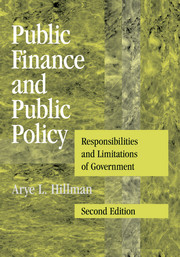Book contents
- Frontmatter
- Contents
- Preface to the Second Edition
- 1 MARKETS AND GOVERNMENTS
- 2 INSTITUTIONS AND GOVERNANCE
- 3 PUBLIC GOODS
- 4 PUBLIC FINANCE FOR PUBLIC GOODS
- 5 MARKET CORRECTIONS
- 6 VOTING
- 7 SOCIAL JUSTICE
- 8 ENTITLEMENTS
- 9 CHOICE OF TAXATION
- 10 THE NEED FOR GOVERNMENT
- TOPICS FOR DISCUSSION
- Author Index
- Subject Index
- References
6 - VOTING
- Frontmatter
- Contents
- Preface to the Second Edition
- 1 MARKETS AND GOVERNMENTS
- 2 INSTITUTIONS AND GOVERNANCE
- 3 PUBLIC GOODS
- 4 PUBLIC FINANCE FOR PUBLIC GOODS
- 5 MARKET CORRECTIONS
- 6 VOTING
- 7 SOCIAL JUSTICE
- 8 ENTITLEMENTS
- 9 CHOICE OF TAXATION
- 10 THE NEED FOR GOVERNMENT
- TOPICS FOR DISCUSSION
- Author Index
- Subject Index
- References
Summary
In our normative analysis, we have until now considered personal decisions in markets (or, in the case of externalities, personal behavior in the absence of markets or in creating markets). The personal decisions were accompanied – and influenced – by public finance and public-policy decisions. Governments made the decisions about public finance and public policy, whereas people made the personal decisions that determined their own personal outcomes. In this chapter, we study collective decisions about public finance and public finance made by voting. People do not, therefore, determine their own personal outcomes by making personal decisions. Personal outcomes are determined through the collective outcome of decisions of voting.
Because the probability of one person's vote being decisive in large voting populations is effectively zero, the reason why people vote may not be that they expect to influence the outcome of voting. Voting may be expressive: voters may express themselves by identifying with a policy or with a candidate, as they might, for example, cheer for and identify with a sports team and be happy or sad according to whether “their” team wins; or, by expressing support for a candidate or political party, a voter may be communicating with and seeking approval from other people. People may also vote as an act of civic duty: they have been taught that taking the time to vote is correct pro-social behavior. Their utility from voting may be from democratic participation. We shall return to the question of why people vote.
- Type
- Chapter
- Information
- Public Finance and Public PolicyResponsibilities and Limitations of Government, pp. 405 - 488Publisher: Cambridge University PressPrint publication year: 2009



